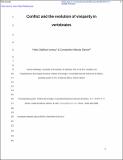Files in this item
Conflict and the evolution of viviparity in vertebrates
Item metadata
| dc.contributor.author | Saldívar-Lemus, Yolitzi | |
| dc.contributor.author | Macías Garcia, Constantino | |
| dc.date.accessioned | 2023-05-05T23:49:40Z | |
| dc.date.available | 2023-05-05T23:49:40Z | |
| dc.date.issued | 2022-05-06 | |
| dc.identifier | 279530360 | |
| dc.identifier | 97fc6ff6-358a-413e-a9bf-47c7ac310012 | |
| dc.identifier | 000791783000001 | |
| dc.identifier | 85129608579 | |
| dc.identifier.citation | Saldívar-Lemus , Y & Macías Garcia , C 2022 , ' Conflict and the evolution of viviparity in vertebrates ' , Behavioral Ecology and Sociobiology , vol. 76 , no. 5 , 68 . https://doi.org/10.1007/s00265-022-03171-z | en |
| dc.identifier.issn | 1432-0762 | |
| dc.identifier.other | RIS: urn:5EDF5AA0957E623EA67D4C6FAE7D7A59 | |
| dc.identifier.other | RIS: Saldívar-Lemus2022 | |
| dc.identifier.uri | https://hdl.handle.net/10023/27524 | |
| dc.description | Funding: CONACyT provided a PhD scholarship (No. 46568) for YS-L. | en |
| dc.description.abstract | Viviparity has evolved from oviparity approximately 142 times among vertebrates. Different theories have been proposed to explain the evolution of each of its traits in the different taxa. None, however, is applicable to all the viviparous vertebrates, since the derived ecological advantages such as controlling incubating temperature or protecting eggs against predation differ amongst clades. Most theories have been developed under a co-adaptive perspective, whereas less attention has been paid to conflict. We developed a broad panorama of the gradual evolution, from oviparity to advanced forms of viviparity, that includes the different environmental and co-adaptive selective pressures that have been suggested to be at the root of the different instances of viviparity and of the diverse maternal–foetal adaptations for nutrient transfer seen amongst vertebrates. Furthermore, we highlight the importance of conflict as a crucial driver of the evolution of many of those traits, including the evolution of epigenetic control of maternal resources. We suggest that the different types of matrotrophic viviparity, and probably also some reversals to oviparity, have been the result of an antagonistic coevolution between mothers, fathers and offspring, and their genomes. We additionally suggest that the appearance of a trait that allowed or favoured the evolution of internal development and matrotrophy generates a new selective environment that promotes further adaptations or counteradaptations, leading to the observed diversity of forms of embryonic development, nourishment, and transfer of maternal nutrients, and ultimately to the diversity of extant viviparous taxa. | |
| dc.format.extent | 21 | |
| dc.format.extent | 639174 | |
| dc.language.iso | eng | |
| dc.relation.ispartof | Behavioral Ecology and Sociobiology | en |
| dc.subject | Lecithotrophy | en |
| dc.subject | Maternal provisioning | en |
| dc.subject | Matrotrophy | en |
| dc.subject | Placenta | en |
| dc.subject | Genomic imprinting | en |
| dc.subject | QH Natural history | en |
| dc.subject | QH426 Genetics | en |
| dc.subject | T-DAS | en |
| dc.subject | AC | en |
| dc.subject | MCC | en |
| dc.subject.lcc | QH | en |
| dc.subject.lcc | QH426 | en |
| dc.title | Conflict and the evolution of viviparity in vertebrates | en |
| dc.type | Journal article | en |
| dc.contributor.institution | University of St Andrews. School of Biology | en |
| dc.identifier.doi | https://doi.org/10.1007/s00265-022-03171-z | |
| dc.description.status | Peer reviewed | en |
| dc.date.embargoedUntil | 2023-05-06 |
This item appears in the following Collection(s)
Items in the St Andrews Research Repository are protected by copyright, with all rights reserved, unless otherwise indicated.

